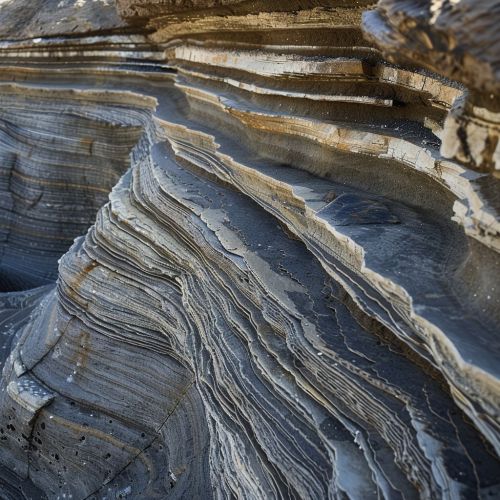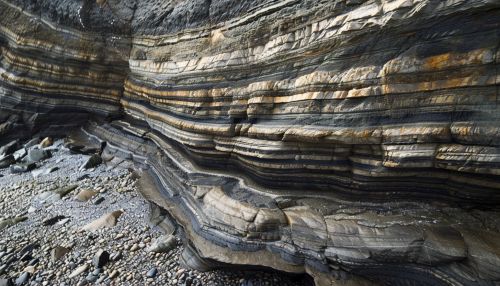Recumbent fold
Introduction
A recumbent fold is a type of geological fold that is essentially horizontal. The term is used to describe a fold where the axial plane, or the plane that divides the fold as symmetrically as possible, is essentially horizontal. This type of fold is a result of intense compressional stresses that result in the deformation of rock layers.
Formation
Recumbent folds form due to intense compressional stresses in the Earth's crust. These stresses can be caused by a variety of geological processes, such as tectonic activity, the movement of glaciers, or the weight of overlying rock layers. The intense pressure causes the rock layers to deform and fold over onto themselves, resulting in a recumbent fold.


The formation of a recumbent fold involves the bending and deformation of rock layers. This process begins when compressional forces act on the rock layers. These forces can come from various sources, such as tectonic activity or the movement of glaciers. As the forces continue to act on the rock, the layers begin to bend and deform.
As the deformation continues, the rock layers can fold over onto themselves, creating a recumbent fold. This type of fold is characterized by its nearly horizontal axial plane. The axial plane of a fold is the plane that divides the fold as symmetrically as possible. In a recumbent fold, this plane is nearly horizontal due to the intense compressional forces that created the fold.
Characteristics
Recumbent folds are characterized by their nearly horizontal axial plane. This is the plane that divides the fold as symmetrically as possible. In a recumbent fold, this plane is nearly horizontal due to the intense compressional forces that created the fold.
Another characteristic of recumbent folds is their asymmetry. Because the forces that create these folds are often not evenly distributed, the folds can be asymmetrical. This means that one limb of the fold may be steeper or longer than the other.
Recumbent folds can also be characterized by their size. These folds can range in size from microscopic to several kilometers in length. The size of the fold is often determined by the intensity of the compressional forces that created it, as well as the type of rock that was deformed.
Examples
Recumbent folds can be found in many different geological settings. They are often associated with areas of intense tectonic activity, such as mountain ranges and fault zones. However, they can also be found in areas where glaciers have moved over the landscape, or where the weight of overlying rock layers has caused the underlying layers to deform.
One example of a recumbent fold is the Matterhorn in the Swiss Alps. This famous mountain is composed of layers of rock that have been folded over onto themselves, creating a recumbent fold. The intense compressional forces that created this fold are a result of the collision between the African and Eurasian tectonic plates.
Another example of a recumbent fold can be found in the Appalachian Mountains in the eastern United States. Here, the movement of glaciers during the last ice age created intense compressional forces that resulted in the formation of recumbent folds.
Significance
Recumbent folds are significant in the field of geology because they provide valuable information about the geological history of an area. By studying these folds, geologists can gain insights into the tectonic activity, glacial movement, and other geological processes that have occurred in the past.
In addition, recumbent folds can also have economic significance. These folds can trap oil and gas deposits, making them important targets for exploration by the petroleum industry.
